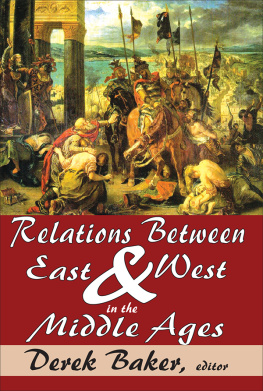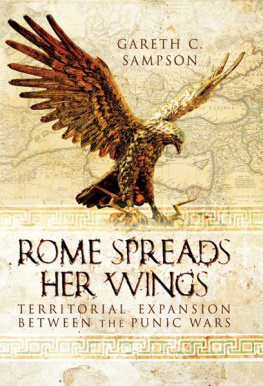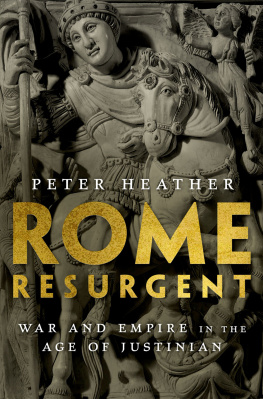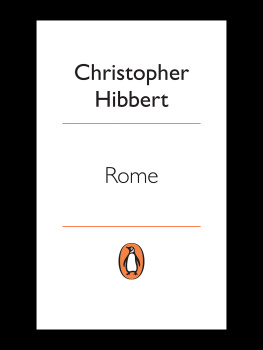About the Author
Andrew J. Ekonomou was educated at Emory University where he graduated magna cum laude and Phi Beta Kappa. After receiving a law degree, he served as Assistant Attorney General for the State of Georgia and thereafter as Assistant U.S. Attorney for the Northern District of Georgia. In 1983, he entered the private practice of law in Atlanta. In 2000, he earned a Ph.D. in Medieval History from Emory, where he teaches Byzantine history and literature. He and his wife, who is a violinist and the orchestra director at a private school, reside in Atlanta.
Epilogue
Zacharias, Son of Polychronios
The Last of the Greek Popes
On the day of Pope Gregory Ills funeral, the Romans unanimously chose Zacharias, then a deacon of the Roman church, to take his place upon the apostolic throne. Five days later he was consecrated pope. Since then, the aging septuagenarian from the heavily Hellenized region of Calabria had lived in the papal residence which over the years he had richly adorned with a portico and tower, bronze doors and railings, and a dazzling new triclinium with marble and mosaics, thus creating a replica upon the Lateran of the Great Palace in Constantinople. Can Zacharias have known that he would be the last in the long succession of Greek popes who had presided over the church of Rome?
Although of oriental lineage and justly proud of their culture and traditions, each of those popes had been unflinchingly Roman by faith, resisting at every turn the Easts proclivity to lapse into doctrinal error and ecclesiastical innovation. Had not the Greco-Palestinian Pope Theodore been a moving force behind the Lateran Council that in 649 had the temerity to ignore an imperial decree and declare Monothelitism to be heresy? Was it not the lengthy concatenation of patristic florilegia sent from Rome to Constantinople by the Greco-Sicilian Pope Agatho that had caused the Sixth Ecumenical Council to anathematize the Monothelite heresy once and for all? Had not the Syrian pontiff Sergius I, targeted for assassination by an imperial spatharios, declared that he would prefer to die rather than accede to those canons of the Quinisext Council that were contrary to the traditions of the church of Rome? Had not his own predecessor of blessed memory, the Syrian Gregory III, admonished the emperors in Constantinople to abandon the error of iconoclasm and return to the ancient customs of the Church? Had he not also sent his own apokrisiarii to the capital, urging the emperor Constantine V to desist from his continued attack on holy images? Surely the popes of oriental provenance had fulfilled their duty to the Roman church as well as any Latin pontiff.
Rome spread out before Pope Zacharias. The city that had emerged from the shambles of the Gothic wars and the Justinianic reconquest of Italy had, over the course of the seventh and early eighth centuries, come to bear the unmistakable imprint of the East. The triumphal column that the emperor Phocas had erected in the Forum around 607 still stood as a reminder that it was not an isolated outpost in the West preserving a purely Latin culture. The ties that bound Rome to the East were palpable and present. The Byzantine administration of the city, headed by the duke of Rome, still occupied the old imperial palace on the Palatine. You could hear Greek spoken throughout the city, especially if you had occasion to trade in the commercial district near the Aventine. Financial obligations were still paid in coins bearing the image of the emperor reigning in Constantinople.; in mid-eighth century Rome, one was practically a Constantinopolitan.
Zacharias may well have shuddered for a moment as his thoughts turned to the Lombards and the Franks. Pope Gregory II had brokered a reconciliation between King Liutprand and the exarch Eutychius, which had temporarily put an end to hostilities between the Lombards and Byzantium on the Italian peninsula. The peoples of the West offered little solace for the Papacy. For Zacharias, the royal city along the Golden Horn was his only consolation.
Like every Roman pontiff who had come before him, Zacharias considered himself a loyal servant of the imperium Romanum Christianum and a dutiful subject of the emperor who occupied the throne in Constantinople. The empire was, after, all the terrestrial image of the kingdom of heaven. It was a sacred realm of which Rome and the papacy were integral components. It represented culture and civilization. It was the irrefragable chain that connected the present to the classical past and gave his beloved Rome the aura of eternity. Most of all, it was the empire that guarded and protected the holy catholic and apostolic church.
Zacharias could not fail to remember the example of his predecessor Gregory II. When all of Italy had risen up against Leo III because of his iconoclastic edicts, the pope had restrained their plan to choose a rival emperor, hoping instead that the emperor might be converted from his error.
In 743, he intervened to persuade Liutprand to cease his campaign against the exarchate. The former imperial capital on the Tiber had adopted and embraced a great deal from Byzantium and the Byzantines in the two hundred years since the reconquest of Italy by Justinian. But that was not surprising to Pope Zacharias. For after all, the Greeks had never really been strangers in Rome.
Notes
1. LP I, pp. 426, 432; Giorgio S. Marcou, Zaccaria. Un Pontefice di Origine Greca, Il Veltro 27 (1983): 14553; Liutprand, Antapodosis, ed. A. Bauer and R. Rau in Quellen zur Geschichte der schischen Kaiserzeit (Darmstadt, 1971), VI, 8; Jan Kostenec, Studies on the Great Palace in Constantinople I. The Palace of Constantine the Great, Byzantinoslavica 49/2 (1998): 27996.
2. The Roman mint continued to strike gold solidi as late as the reigns of the emperors Leo III, Artavasdos, and Constantine V. Philip Grierson, Byzantine Coins (London, 1982), Plate 39, nos. 7079, 71617 (Leo III); no. 710 (Artavasdos); nos. 71213, 71820 (Constantine V).
3. In order to accommodate the increasing number of Eastern monastics who arrived in Rome during the eighth century, Latin communities were in some cases transferred to Greek monks. Sometime between 768 and 773, for example, Pope Stephen III transferred the monastery of St. Andrew, which had been founded in the late sixth century by Gregory the Great in his ancestral home on the Caelian Hill, from Latin to Greek control. PL 75: 229. Claiming the transfer to have occurred by necessity more than desire, John the Deacon, in an unrestrained expression of anti-Greek sentiment, yearned for the day when it would be returned once more, to the Latin mode of worship, the Lord willing. Id. His wish appears, however, to have remained unfulfilled, for a century later, in the time of Pope Nicholas I (858867), St. Andrews was still ruled by a Greek abbot named (ironically) Zacharias. Id., 236.
4. LP I, p. 435; PL 75: 225; see also Ivan Havener, The Greek Prologue to the Dialogues of Gregory the Great, Revue Bndictine 99 (1989): 103. The wide audience that the Dialogues achieved in the East as a consequence of Pope Zachariass translation was almost certainly responsible for Gregory the Great becoming recognized as St. Gregory Dialogos by the eastern churches. See Viktor Matthaiou, ed., Paulos Evergetinos: Synagoge ton theophthongon rematon kai didaskdlion ton theophoron kai agion pateron, 3 vols. (Repr. Athens, 19571964).
5. Cyril Mango, La Culture Grecque et lOccident au VIIIe Sicle, in I Problemi dellOccidente nel Secolo VIII, 612 April 1972, Settimane di Studio del Centro Italiano di Studi sullAlto Medioevo, Vol. 2 (Spoleto, 1973), pp. 70910; E. Dekkers, Les traductions grecques des crits patristiques latins, Sacris Erudiri 5 (1953): 202; H. Delehaye, La Vie grecque de S. Martin de Tours, Studi bizantini e neoellenici 5 (1939): 428ff. For the passion of St. Denys, see BHG 554, which Mango describes as a bad translation of BHL 2178, Mango, id., p. 710n118, and R. Loenertz, Le pangyrique de S. Denys lAropagite par S. Michel le Syncelle, Analecta Bollandiana 68 (1950): 225ff. For the passion of St. Anastasia, see H. Delehaye, tude sur le lgendier romain, Subsidia hagiographica 23 (Brussels, 1936): 155.











